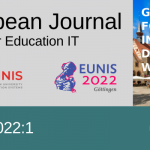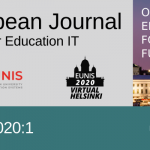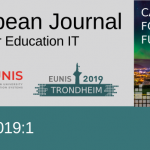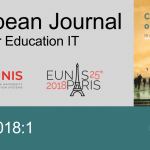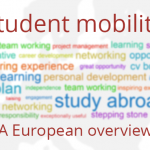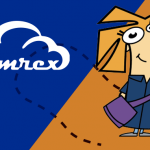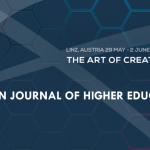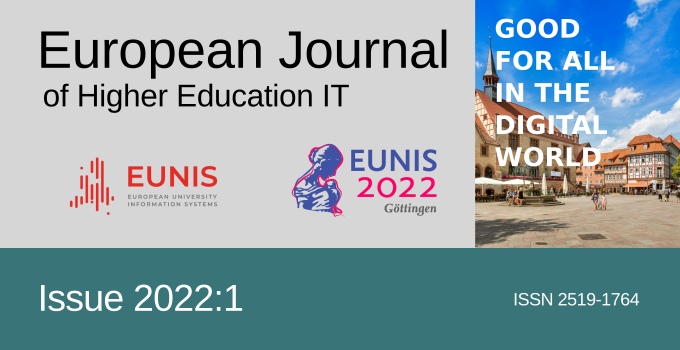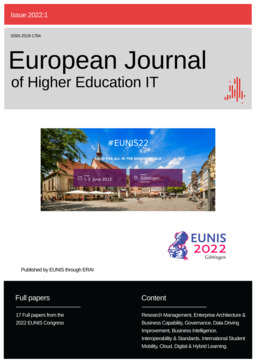
Reference to articles in this issue should be made as follows: name of author(s). title, European Journal of Higher Education IT 2022-1, EUNIS
European Journal of Higher Education IT – EJHEIT
This issue of the European Journal of Higher Education IT (2022/1) consists of a selection of the full papers from the EUNIS 2022 congress.
A total of 45 papers were submitted to the congress, 20 of which are published here.
In this issue there are a variety of themes covering topic of Research Management, Enterprise Architecture & Business Capability, Governance, Data Driving Improvement, Business Intelligence, Interoperability & Standards, International Student Mobility, Cloud, Digital & Hybrid Learning.
European Journal of Higher Education IT is a journal created to support the mission of EUNIS and to disseminate International Research within the field of higher education IT. Please also refer to the Editorial Committee.
ISSN 2519-1764
Research Management
VIVO-based Research Information Platform for the Berlin University Alliance
Fadwa Alshawaf, Claudia Adam, Rolf Guescini, Florian Kotschka, Malte Dreyer
Abstract
This paper describes our efforts on developing a platform for presenting structured, transparent, categorized, and linked information about researchers and their research activities within the framework of the Berlin University Alliance (BUA). This will improve the discoverability of expertise, connect researchers to their work across disciplines and boundaries, and facilitate new research collaborations. The platform is established using the open-source, web-based VIVO software, which uses semantic web techniques to connect research outputs, organisations, people, things, and research activities. This is achieved by developing ontologies that relate and connect these entities within the alliance.
Polish Platform of Medical Research with OMEGA-PSIR an Open Science approach
Jakub Koperwas, Łukasz Skonieczny, Renata Sławińska, Henryk Rybiński
Abstract
With the IT technology development, the Open Science movement, aiming at making scientific research and dissemination of its output accessible to all levels of society, amateurs or professionals, evolves from large bibliographic data, addressed mainly to the scientists, through Open Access movement, along with open scientific repositories and archives, recently ending with integrating institutional repositories (IR) with Current Research Information Systems (CRIS). Some newer IT solutions go further, extending systems by functionalities enabling dissemination of multitudinous aspects of research activities. OMEGA-PSIR, developed at the Warsaw University of Technology (WUT), combines functionalities of IR, CRIS and Research Profiling Systems (RPS). Now, adopted by more than 34 scientific institutions in Poland, the system shows usefulness not merely for the university management people, not only for the research community, but also for the society. A good example of implementing Open Science ideas in Poland is the Polish Platform of Medical Research, which is a unique project that covers a number of institutional OMEGA-PSIR implementations at medical universities and research institutes, and provides a central database that integrates the information from the local systems. In the paper we discuss various aspects of Open Science, referring to the successful implementation of the Polish Platform of Medical Research.
Enterprise Architecture & Business Capability
Towards a sector specific Enterprise Architecture model – introducing HERM
Gerolf Nauwerck, Patrik Maltusch, Valerie Le Strat, Esa Suominen
Abstract
Enterprise Architecture (EA) is often considered critical to higher education’s digital transformation. Up until now the higher education sector has mainly relied on generic models or even models imported from other sectors. In 2021, the higher education reference model (HERM) was introduced, giving the sector a common platform with solid support from various communities such as CAUDIT, EDUCAUSE, UCISA, and EUNIS. This paper takes a practitioner’s perspective introducing the concepts of EA, the business model canvas, business capabilities, and a short introduction to HERM. The paper concludes with an overview of best practices to get started with EA in general and HERM in particular.
Visualising the digital transformation of research data management and student administration the Milky Way
Monica Lassi, Gerolf Nauwerck, Anna Winckler, Michael Cederberg
Abstract
This paper presents a novel enterprise architecture concept for mapping business capabilities called the Milky Way. It aims to create an anchoring image that can be used to communicate with various stakeholders. We look at examples from research data management and student administration. All the presented projects, from different universities, were highly successful in achieving stakeholder buy-in. The paper ends with lessons-learned and we conclude that this is a very promising avenue for further exploration in the higher education sector.
Governance
Self Service Campus: an online tool for network management delegation
Claudio Teixeira, João Paulo Barraca, Carlos Costa, Dimitri Silva
Abstract
Self-Service Campus (SSC) goal is to enable technical field staff to tke on daily tasks within campus. To complete their tasks autonomously, staff are required to access and configure network equipment, such as switches, to define port security and access rules. In a troubleshoot scenario, access to the same switches is required to take a closer look at logs. These are privileged accesses on sensitive equipment, typically using command line tools, meaning that extensive command knowledge is required. Even experienced technicians may, unwillingly, remove previous configurations, or misconfigure ports, with potential security issues or out of service situations.
The SSC is an online tool for graphic based network configuration, encapsulating a subset of possible operations using an API developed on top of Cisco Prime APIs (Application Programming Interfaces), combined with role-based access controls, with fine-grained access control to features on network equipment.
This paper presents the overall architecture set in place to support applications like the SSC in a sustained and generic way, with special focus on this particular implementation.
Good for all in the digital world: geeks, unicorns and European public values
Christien Bok, Gill Ferrell, Pekka Kähkipuro, Ewoud de Kok, Jasmijn Jacobs-Wijn
Abstract
The European Commission and Europe’s political leaders have great ambitions for digital transformation to deliver public services and economic growth in ways that are compatible with European public values.
A high quality, digitally-transformed education system plays a major role in this vision. Considerable investment is being made to develop borderless higher education and a mobile workforce. One of the most significant developments is the European Universities initiative in which a number of EUNIS institutions are participating.
However, the grand aims of digital transformation and transnational collaboration are all too often mired in the realities of inefficient business processes, poor data quality and lack of interoperability. Moreover, the more we open ourselves up to Europe-wide and global collaboration, the more we fear loss of sovereignty over our data, infrastructure and processes.
This paper investigates what EUNIS stakeholders (who include individuals, universities, NRENs and suppliers) can do to ensure that growth and collaboration can happen in ways that are compatible with European public values. We look at how the 1EdTech community is developing a technical ecosystem in line with these values and we review work in the Netherlands led by the Dutch NREN, SURF, as an example of good practice in this area.
Driven by Data
For your eyes only: Leveraging existing data to facilitate individual course evaluation report delivery and integration into QA or BI tooling!
Joris de Vries
Abstract
We will show how the HSG uses data integrations to automate course evaluation report distribution to individual instructors. We will also look at strategic implications of using the same data as the rest of the institution beyond just report delivery, such as opportunities to integrate into quality assurance or institutional management processes through enabling feeding back data to business intelligence solutions.
Personalized student experience through a standardized IT infrastructure
Reinhard Landes and David Rapp
Abstract
While many students start questioning the value of higher education, universities need to find ways to improve student satisfaction to remain attractive. Offering a personalized experience to students can drive engagement and bring universities in a better position in the competition for new enrollments. By collecting and harmonizing all data across the campus, universities can use intelligent technologies to help build a personalized student experience. For that, we outline the roadmap to build a resilient foundation of back–end tools to drive a single–source–of–truth for all university data forcing clarity into front–end applications that deliver the personalized experience to students providing insights into student sentiment and behavior. By highlighting a recent SAP proof of concept with a renowned US–university, we present an example of how machine learning capabilities can enhance student advising with data–driven, personalized insights.
Customisable analytical platform for public statistics
Aldona Tomczyńska, Emil Podwysocki, Sylwia Ostrowska
Abstract
In this article, we showcase an analytical platform developed by the National Information Processing Institute (OPI PIB) and share the rationale behind its design. We also draw attention more broadly to the benefits of analytical platforms for the science and higher education sector. We demonstrate how analytical tools other than popular licensed business intelligence systems can be utilised by research organisations and decision-makers. We offer a brief comparison between licensed business intelligence tools and on-premises analytical platforms. By including an extensive overview of the technical architecture of our own software solution, we provide readers with a ready-to- use guide to the organisation of different layers of analytical platforms that can be integrated easily in any IT environment. Finally, we describe an implementation of the OPI PIB analytical platform for the purpose of the Genderaction project, which was financed as part of the Horizon 2020 programme of the European Union. By presenting data on women in science and higher education, the platform promotes progress towards the implementation of gender equality in research and innovation.
Interoperability & Standards
Interoperability of educational data demands standards
Tor Fridell, Geir Vangen, Janina Mincer-Daszkiewicz, Jan Joost Norder, Jukka Kohtanen, Igor Drvodelić, Guido Bacharach
Abstract
Student mobility is a keystone in the building of the future Europe but mobility requires transfer of educational data. This interoperability of educational data demands standards. There are basic regulations, like ECTS (European Credit Transfer and Accumulation System), which defines grading rules and transfer of credits, and ISCED (International Standard Classification of Education), which defines educational levels and subjects. There are also EU standards for data transfer, like EuroLMAI (EN 15981) and MLO (EN 15982). However, the implementation of the standards differs slightly and in practice there is more than one standard. The possible implications for the end user are that there will be “silos” with different systems not being able to communicate and there will be no mobility of data.
This can and should be solved by cooperation with the long-term goal to unite standards and until then by building converters between them. This paper describes regulations, different standards, ongoing work and ways to go forward.
Click and connect: solving integration issues with LTI (learning tools interoperability)
Xavier Aracil Diaz, Antoni Bertran, Martin Lenord, Bracken Mosbacker, Gill Ferrell
Abstract
Digital transformation has already happened for many universities. The shift to massive use of digital tools, whether this was an acceleration of existing strategy or an emergency response, has taught us some important lessons that need to be carried forward into future strategy.
Students and tutors don’t just need digital tools: they need digital tools that work well together. Universities need the flexibility to create an ecosystem that works for all of their learners. This paper explores how open standards make this possible.
We take a general look at what is meant by open standards and the benefits they deliver for institutions and for suppliers. We then take a deeper dive into the LTI (learning tools interoperability) standard. LTI is already the lifeblood of much of the learning tools ecosystem (most universities will be using it whether or not they realise this). New developments make it easier to support a range of integrations ‘out of the box’ and take some of the administrative work out of aspects of GDPR compliance.
International Student Mobility
DE4A Project: Towards a Single Digital Gateway for European Public Services
Jose Pascual Gumbau Mezquita, Francisco José Aragó Monzonís, José Traver Ardura
Abstract
Single Digital Gateway regulation is settling the grounds for the effective cross- border interoperability of European public administrations at the data and business procedure levels. As the natural step beyond the basic cross-border authentication interoperability eIDAS regulation is currently bringing forward, a core set of common administrative procedures including higher-education related administrative procedures has been identified, and efforts in all member states are underway to analyse them and agree on a common set of specifications to allow a citizen from any European state to complete the procedure in another state without having to produce any physical documentation, and what’s more important, nor digitalised copies of said documentation which increases fraud risk and would require additional validation efforts. This regulation will enable a safer, more trusted, quicker, less costly, and easier procedure both for the citizen and for the administrations. DE4A project is an initiative by a strong consortium of multiple state agencies and other stakeholders in different sectors, both public and private, including universities. The project goal is to experiment the feasibility of deploying and running those procedures in a real environment, to identify the pitfalls and gain practical knowledge on the legal, technical, operational and governance challenges that will be faced by the SDGR implementors. This article will provide an overview of the developed infrastructure and its capabilities, as well as specific insight on the provisional outcomes of the academic pilot, still under execution until the end of 2022.
A new approach to digital degrees
Anna Sandberg Telléus, Anna Lindgren
Abstract
In a time of ever-increasing digital transformation, we see that all areas in the society need to constantly adapt to this development, not least the education sector. This in combination with international mobility calls for continual evaluation of the student administration processes, to ensure the students and alumni to be able to access and share the qualifications they have earned.
To meet these requirements, the development of an improved and further digitized system for digital degrees in Sweden is taking place. The functionality is based on the approach that instead of focusing on the document (i.e. the degree certificate) the focus is on the digital decision which is made and saved digitally. There will still be a document, but this will merely be a representation of the actual decision and therefore have no further legal meaning. This way of looking at the document makes it possible for the student to retrieve new documents when needed.
Cloud
Co-operative Service Design for a Cross-University Data Backup Service
Thomas Eifert, Nicole Filla
Abstract
Every part of a university nowadays is highly dependent on data, be it research, teaching or administration. In the meantime, the diversity of data storing device types increases while the amount of data is growing exponentially in the age of the Internet of Things. Starting from this dependency on data of almost every aspect of a university we are running a cross-university project in the German federal state of North Rhine- Westphalia (NRW) with the aim to build up a cross-university co-operative service for data protection. We derived work packages in order to define the future state-wide service according to the technical, procedural and functional requirements as well as to the expectations and demands of our stakeholders, the latter being confirmed by a survey.
The goal is to fundamentally improve data backup and data availability through the cooperatively provided basic IT service “Datensicherung.nrw” using cross-university processes. This is accompanied by a significant improvement in cyber security and ensuring the digital capacity to act of the participating universities, as well as the creation of synergies in the field of cooperative digitization among the state universities of North Rhine-Westphalia.
Sourcing, multi cloud environments and a changed environment for central IT
Denise Dittrich, Thomas Eifert
Abstract
Many users at universities already use cloud services from various providers to achieve their goals in research and teaching better. The reasons are manifold, from functionality and the convenience to share work and collaborate with peers to quick availability. On the other hand, universities as well as the users themselves need to keep control of their data, for their own vital interests as well as for legal requirements. However, to withhold users from cloud usage will only strengthen “shadow IT”, so Central IT has to find a way to manage multi cloud environments and thus pave the way for a structured usage of these offering. With this it is possible to make clear the necessity and value of local IT services.
This can be done by emphasizing existing and implementing new values to services or by adding public cloud services into the service portfolio while providing a secure and integrated framework.
Digital & Hybrid Learning
Shaping the digital education in a new normal: teacher experience
Anna Pacholak
Abstract
The paper presents a summary of findings from the teacher digital experience insights survey carried out among lecturers of the University of Warsaw in the end of the winter semester 2021/22.
It provides an overview on how teachers perceive the effectiveness of the teaching and learning with the engagement of digital tools. They share opinions on what digital tools were most commonly used at their courses during the pandemic, when they had to face emergency teaching circumstances and, from day to day, shift their classes to the online mode. The feedback information includes an assessment of their reliability and usefulness in the education process. The lecturers also indicate the advantages and disadvantages of digital education, revealing its potentials and barriers and share their experience from the last semester teaching when they were granted more freedom in deciding on the form of their classes.
The outcomes are put together with the results of the survey on student digital experience during the pandemic and findings obtained in other similar research carried out at European universities.
Hence, the insight delivered in the survey is valuable for identifying which digital methods should be developed further and adapted to the blended model of post- pandemic education.
Was the increased use of e-learning platforms during the global pandemic caused by COVID-19 a factor in the development of digital educational innovation in France?
Frédérick Bigrat
Abstract
The global pandemic caused by the Coronavirus 2019 (COVID-19) forced higher education, research institutions and teacher-researchers in France to develop accelerated use of e-learning in order to ensure continuity of their teaching. Thus, face-to-face teaching was no longer the norm and gave way to other modes of operation. Institutions were closed, emptied of their students, and one could observe either teachers-researchers connecting from their homes through platform systems or from classrooms that were sometimes open on certain campuses, thus allowing teachers-researchers to record themselves and broadcast a course live to their students. Between two lockdowns, under cover of sanitary constraints (mandatory masks, social distancing, hydro-alcoholic gels, etc.), some institutions set up hybrid courses (50% of students were present and 50% followed the course at home with a principle of alternation). In this very particular teaching context, have new teaching practices emerged with regard to the more restricted use of digital tools ?
Removing barriers in digital education. Deployment and licensing solutions as building blocks to greater inclusivity in the digital transformation.
Lieke Veenhuizen and Dawn Nell
Abstract
Digital transformation is having far-reaching implications for societies, organisations and individuals. As the digital transformation has seen ICT reach into every part of university learning, concerns have grown around ensuring that digitalisation is inclusive. Inclusivity in education “enables people to be educated in a diversity of spaces at all times, removing barriers and bias regarding their learning potential.” Implicit in calls for the promotion of inclusivity in education is the recognition that students are not a homogeneous group. A number of factors can have an impact on the ability of a student to access learning in the university setting, and their engagement with university ICT. Academic Software has been providing solutions in the educational sector for more
than a decade, and its experience points to a shift in which questions of inclusivity in digital education in the European context are increasingly less about access to computers, and more about ensuring the equity objective is followed through in deployment and licensing. This paper is intended to contribute to increasing awareness of the importance of licensing and deployment/provisioning in any interventions aimed at improving digital inclusivity.
Automated feedback: an AI-powered tool to scale micro-level feedback for better academic writing
Ziwei Huang and Wilco te Winkel
Abstract
Reviewing written work – whether between peers or from teacher to learner – can be an
arduous process, exponentially more so within larger student cohorts. With that large potential
time-sink, even less time is available for teaching. In addition, the majority of instructors’ time is
focused on correcting spelling, grammar, style, and semantics, rather than content and argumentation.
These are ‘micro-level’ or ‘lower-order’ concerns: the writing aspects unrelated to argumentation or
reasoning such as grammar, spelling, or reference. Focusing on these would divert teachers from
providing feedback on ‘higher-order’ writing aspects: argumentation, reasoning, style and flow. This
then increases teachers’ workload while reducing the feedback quality delivered to students.
In order to address this issue, FeedbackFruits – an educational technology provider for
higher education – collaborated with Erasmus University Rotterdam, Rotterdam University of
Applied Sciences, and Deakin University to develop an AI-powered academic writing tool,
Automated Feedback. This tool provides instant formative feedback for students on their lower-order concerns (such as correct references and grammar) to iteratively improve their writing product before handing in the final version. That is, teachers set up feedback criteria for students’ assignments covering elements such as structure and content, academic language, citations and references, tables and figures within the tool. To fit into teachers’ existing workflow, the tool integrates with different learning management systems (LMSs) including Canvas, Brightspace, Moodle, and Blackboard. Based on the teacher-configured rubric of feedback criteria, Automated Feedback analyzes the assignment and provides actionable feedback for students, thus helping them develop their academic writing skills, while reducing the reviewing workload of the teacher.
Deliver knowledge in a Digital World: Successfully Livestream In-Person, Virtual or Hybrid large-scale educational events – Challenges and best practices
Georgios Roussos, Dimos Charidimou, Vasiliki Kalfa, Anastasios Petalotis, Angeliki Agorogianni
Abstract
The rapid transformations that the Covid-19 pandemic brought to educational institutions worldwide have already shaped the next steps of academic reality. Institutions have experienced unprecedented changes in learning practices and relations, bringing an interconnection of a multidisciplinary community to focus. As the academic activities are slowly reconstructing from a strictly online approach to a more hybrid one, solutions are forming in order to provide the best model for the new requirements. Therefore, universities are at the forefront of this transformation by being the main stakeholders influencing the advancements in hybrid educational activities and the first consumers of new technological solutions. Live stream hybrid events are the latest trend. The paper tackles the case of Aristotle University of Thessaloniki (AUTh) on how the university delivers live stream large-scale educational events for in-person, online/virtual, and hybrid mode. Moreover, the paper sheds light on the challenges brought forth, the solutions implemented, and what proposals are designed to improve the services offered.

